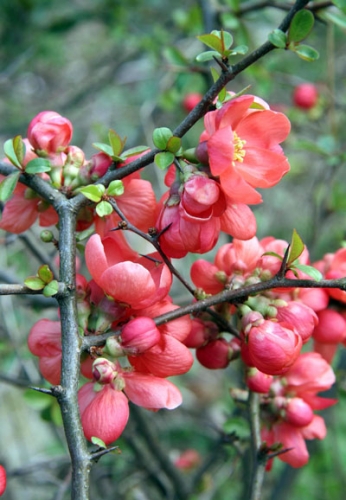Remember the quince?
An old-time favorite, the quince is still around in some gardens.
In the spring, there is an embarrassment of flowers blooming everywhere. For shrubs, the flowers are mostly shades of yellow, white or pink. But every so often, a brilliant, red-orange or red-flowered shrub with a round shape is seen in a yard. When found, they are often planted at an older home and have probably been gracing that spot for many decades.
|
The color explosion is called a quince, which is a shrub. There are two types of quinces. The brilliant orange or red variety is Chaenomeles speciosa. It often grows to a height and spread of 10 feet and has thorns. A related variety, Cydonia oblongata, grows even larger with a height of 15 to 20 feet and is not spiny. Its flowers are white to soft pink. Both produce an edible fruit called a pome that has a diameter of about 3.5 inches. The fruit ripens on the bushes, turning yellow in October. When picked, the fruit has a fragrant, almost perfumed skin, but is hard as a Bocce ball. As is, human teeth will not take on this rock-hard fruit. The pomes are also quite bitter if eaten raw, but when cooked and sugar is added, the flesh can be made into jellies, preserves, fruit leather and the quince version of applesauce. It is a delicious treat.
But the quince has dropped out of the public landscaping eye in the last several decades. The reasons are obvious. It is kind of a coarse shrub. The 10-foot variety has thorns. Both quinces have lovely flowers that may last only one or two weeks a year in the spring. For the rest of the time, there are green leaves that do not turn any exciting color in the fall. And for almost all quince owners presently, there is that annoying fruit to pick up and throw away.
If you have the room on your property and want to add an old-time favorite to your landscape, think about planting a red-orange quince. Quinces are still available to buy through catalogs or online. Since it is an almost forgotten landscape plant, it may be difficult to find in your local nursery.
If having quince fruit is of interest, consider Cydonia oblongata. It tends to be a more attractive landscape plant. It just doesn’t have those flame-colored flowers.



 Print
Print Email
Email



